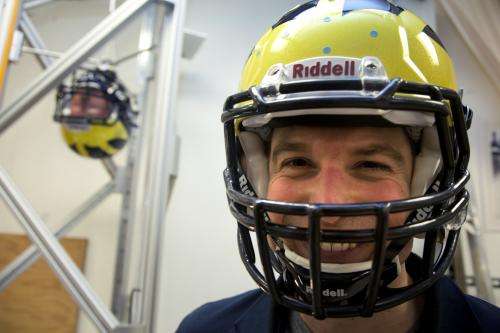Understanding concussions: Testing head-impact sensors

The head of a crash-test dummy wore a football helmet as it hung upside down on a laboratory drop tower.
Dr. James Eckner stood on a ladder next to it holding its tether. He counted to five and let go.
The bust smacked into another just like it three feet below—with about the force of two linemen colliding at the start of a play.
How hard was the hit? Where was it centered? And what reactions did it cause in the defensive dummy head? Sensors sent answers to a laptop across the room.
It'll take weeks for the researchers to analyze the data from several days of drops—part of an effort in the University of Michigan's Biomechanics Research Lab to help improve understanding of how the head and brain react to impacts. It's a ripe field, as the sports and science communities are becoming aware of the devastating long-term effects that decades' worth of concussions and head hits can have on players.
"There's a growing number of athletes that seem to be affected by these later on in life," said Eckner, assistant professor of physical medicine and rehabilitation at the U-M Medical School. "But most athletes don't seem to have these problems as they age, and so the tricky thing is to figure out what is causing this in one athlete, but not in another."
Chronic traumatic encephalopathy, a progressive and degenerative disease that involves early-onset dementia, depression and trouble controlling impulses, has been found in the autopsied brains of more than 50 former NFL players. The league has agreed to a hefty settlement with thousands of former players who say officials hid the dangers.
This U-M experiment won't immediately address the question of why some exhibit symptoms down the road and others don't, but the researchers are laying groundwork for finding the answer. They're comparing two high-profile head-impact monitoring systems—Riddell's Head Impact Telemetry System (HITS) and the newer X2 Biosystems' X-Patch. Their goal is to see if the readings match up so researchers can better interpret the data the newer system provides.
"There are a lot of papers written using the HITS, but there really aren't papers written yet that use the X-Patch system. When they start to be written, we want to make sure we're comparing apples to apples," Eckner said.
"There's a growing number of athletes that seem to be affected by these later on in life," said Eckner, assistant professor of physical medicine and rehabilitation at the U-M Medical School. "But most athletes don't seem to have these problems as they age, and so the tricky thing is to figure out what is causing this in one athlete, but not in another."
Chronic traumatic encephalopathy, a progressive and degenerative disease that involves early-onset dementia, depression and trouble controlling impulses, has been found in the autopsied brains of more than 50 former NFL players. The league has agreed to a hefty settlement with thousands of former players who say officials hid the dangers.
This U-M experiment won't immediately address the question of why some exhibit symptoms down the road and others don't, but the researchers are laying groundwork for finding the answer. They're comparing two high-profile head-impact monitoring systems—Riddell's Head Impact Telemetry System (HITS) and the newer X2 Biosystems' X-Patch. Their goal is to see if the readings match up so researchers can better interpret the data the newer system provides.
"There are a lot of papers written using the HITS, but there really aren't papers written yet that use the X-Patch system. When they start to be written, we want to make sure we're comparing apples to apples," Eckner said.
By helping to identify more concussions—more points when players should be sidelined for a game or even a season—tools like these stand to make football and other sports safer when coupled with trained experts, the researchers say. They might also be used to keep track of wallops over a player's career and raise flags as they rack up. And more immediately, they could help researchers test whether wearing certain equipment or strengthening particular muscles could help players protect themselves.
Using the sensors, Ashton-Miller, Eckner and their colleagues on the Michigan NeuroSport team in kinesiology and neurology are studying differences in head impact exposure in men's and women's ice hockey. And they're doing some of the first studies on how neck strength influences head motion after collisions in young people.
"I think the ultimate goal is still that one could predict which hits are going to cause concussions based on the biomechanics of the impact," Eckner said. "We're a long way away from that goal, but it would be the greatest benefit that these systems could provide to help players, coaches, team doctors and athletic trainers."
















